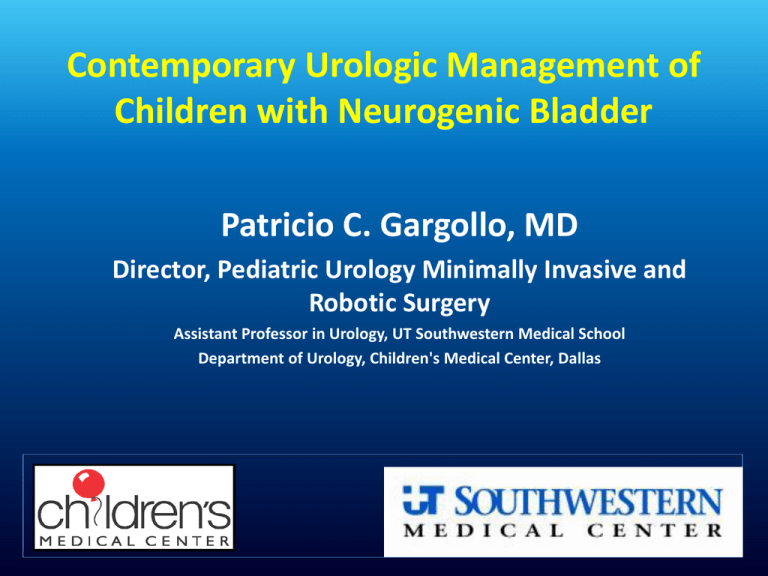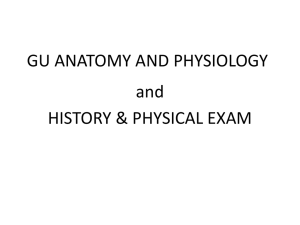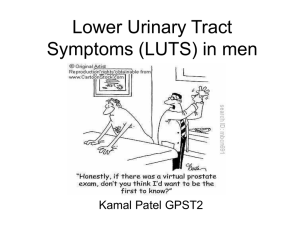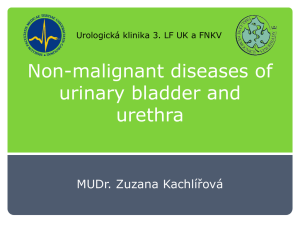
Contemporary Urologic Management of
Children with Neurogenic Bladder
Patricio C. Gargollo, MD
Director, Pediatric Urology Minimally Invasive and
Robotic Surgery
Assistant Professor in Urology, UT Southwestern Medical School
Department of Urology, Children's Medical Center, Dallas
Who am I and how did I get
here?
• Baylor University Graduate
• Harvard Medical School
• Massachusetts General Hospital and
Harvard Medical School
– 2 years general surgery
– 4 years urology
• Children’s Hospital Boston
– 3 years pediatric urology
– Advanced fetal care center
– Advanced Laparoscopic training
Paradigm Shift
• Medical Therapy and Management
–
–
–
–
Less Antibiotics
Less Radiation
Less Screening
Less Testing
• Surgical therapy
– Laparoscopic Surgery
– Robotic Assisted Surgery
• Less Pain
• Less Scars
• Less Time in the hospital
Outline
•
•
•
•
•
•
Urology Goals
Physiology
Bladder Function/Malfunction
Bowel Function/Malfunction
Urology Studies
Surgical Treatments
Spina Bifida
Classification
Myelomeningocele
Meningocele
Lipoma of the cord
Occulta
Etiology
Risk Factors
Sex
Ethnic Background
Diet
Medications
Diabetes
Obesity
Socioeconomic status
Prevalence
166,000 affected in
the US
1 in 1,000 live births
Texas Scottish Rite
• 500 active patients
with MM
• 25 newborn patients
annually
Spinal Defects Clinic
•
•
•
•
•
•
Integrate care among all specialties
Provide “one-stop” shopping
Patient Population: 500 patients
Tuesday s
14-18 patients 12:30-6 pm
Patients 1 month-2 years old
– Seen every 3-6 months
• Patients 2 years and older
– Seen every 6 months to 1 year
Spinal Defects Clinic
Providers
• Specialists:
– Physiatrist
– Orthopedist
– Neurosurgeon
– Urologist
– Occupational Therapy
– Physical Therapy
– Social Work
– Nursing
– Project Nicaragua
NGB: CHILDHOOD MILESTONES
birth - toilet training (3-4 yrs)
continence management (TT- middle school)
teenage rebellion
transition to adult care
Goals
• Preserve renal function
– No dialysis!
• Achieve social continence
–
–
–
–
Bladder
Bowel
No diapers!
Independence
Neural Pathway
Bladder Function
Bladder
• Overactive
• Underactive
• Normal
Sphincter
•Overactive
•Underactive
•Normal
Detrusor Sphincter
Dyssynergia
Bladder
-Overactive
Sphincter
-Overactive
Neurogenic Detrusor
Overactivity
Bladder
-Overactive
Sphincter
-Underactive
Areflexic Bladder
Bladder
Underactive
Sphincter
-Underactive
Bowel Function
Bowel Function: “Pellets”
Bowel Function:Diarrhea
Urology Studies
•
•
•
•
Renal/Bladder ultrasound
VCUG
DMSA
Urodynamics
Urology Studies
• Renal/Bladder ultrasound
Urology Studies
• Renal/Bladder ultrasound
Urology Studies
• VCUG (Voiding cystourethrogram)
Urology Studies
• DMSA
Urology Studies
• UDS (Urodynamics)
Bladder Pressure
Sphincter Activity
Rectal/Abdominal Pressure
Pressure
Time
Activity
Time
Pressure
Time
Management and Outcomes
• No longitudinal studies of renal function, scarring
• Few longitudinal studies of bladder compliance
Means to Assess
Need for therapy, results, determined by:
• Imaging
Renal US
VCUG
DMSA
• Urodynamics
Background
• Goals for management:
– Preserve renal function, prevent scarring
– Preserve bladder compliance
• No evidence that management impacts
outcomes
• Reported endpoints
– New HN, VUR
– Change in UD
– Augmentation rates
Management Options
• 3 options for management of children
with MM from birth – age 3y:
– Imaging-based observation
– Universal therapy (CIC + anticholinergic)
– UD-based selective therapy
Surrogate Outcomes of Management
• Incidence of new HN, VUR
does HN or VUR predict renal damage?
• Development of adverse UD parameters
does tx prevent changes?
does tx restore compliance?
• Augmentation rates
management failure vs management decision?
Newborns: Tx vs Observation
• No evidence shows universal treatment superiority
• No study shows impact of tx on care-givers
• Cost catheters, oxybutynin
Newborn Protocol
• ≤ 6 wks age
Fluoroscopic UD
Renal US, DMSA
• Renal US q 3mos x1y
q 6mos
UD, DMSA 1yr, 3yr
• Tx for:
high risk UD + HN, VUR
new HN, VUR, ∆ DMSA
• High Risk UD
filling pressure> 40cm
Patterns:
Initial Assessment: UD
•
Varying Methods
5-7Fr UD catheters
infusion 1.5- 15cc/min
monopolar needle vs patch electrodes EMG
• Varying Terminology
upper, lower motor lesions
detrusor hypertonicity vs overactivity
• Varying Diagnoses
DSD vs no DSD
Results: Initial UD
71 pts, mean age 3m (2wk – 6m)
Category
Number of pts
“Normal”
16 (23%)
No detrusor contraction
22 (31%)
<25 cm H2O
9
25-40 cm H2O
9
>40 cm H2O
4
Detrusor overactivity
33 (46%)
<25 cm H2O
12
25-40 cm H2O
8
>40 cm H2O
13
Results: Initial UD
71 pts, mean age 3m (2wk – 6m)
Category
Number of pts
“Normal”
16 (23%)
No detrusor contraction
22 (31%)
<25 cm H2O
9
25-40 cm H2O
9
>40 cm H2O
4
Detrusor overactivity
33 (46%)
<25 cm H2O
12
25-40 cm H2O
8
>40 cm H2O
13
“High risk
DLPP or Storage Pressure?
Same risk?
DLLP 50 cm
Pressure during storage is more important than compliance
Churchill et al, 1994
Selective Therapy (UD-based)
• UD identifies high risk before deterioration
• Therapy prevents renal, bladder damage
• Preserve renal function, decrease augmentation
Outcomes
71 pts
Initial UD
High risk UD
17 (24%)
F/u UD
F/u UD
Treatment
n=12
Observation
n=5
EFP <40
n=12
1 new HN
No new HN/VUR
Low risk UD
54 (76%)
6/54*
Δ to risk UD
1 new HN+VUR
* UD changes at
mean 9mo (4-12)
1 new HN,
2 new VUR
Outcomes
• Renal damage:
• 25% f UTI:
no data, f/u DMSA pending
9/17 (53%) high risk
9/54 (17%) low risk
10/18 (56%) CIC vs 8/53 (15%) obs , p=.001
• 18% VUR:
11/71 (15%) initially
3/60 (5%) new
Renal Outcomes: Baseline DMSA
38 patients
– 35 (92%) normal scan
– 3 (8%) abnormal scan, congenital nephropathy?
Pt
DMSA finding
1
Initial UD Pattern
EFP
Initial u/s
Initial
VCUG
fUTI
Unilateral, CRN
20
No hydro
No VUR
No
2
Unilateral,
focal scar
40
No hydro
No VUR
No
3
Unilateral, CRN
62
Unilateral
SFU Gr 3
Gr 5, 3
Yes
Renal Scar: Risk Factors
95 pts NGB
7±4yrs
32% DMSA renal scar
MLR analysis:
VUR OR 8.12 (95%CI 2.92 – 23.14)
no UD parameter
bladder capacity
DLPP>40cm H2O
[40% taking anticholinergics]
DSD
detrusor overactivity
Leonardo et al, 2007
Renal Scar: Risk Factors
DMSA, UD in sequential pts
2005-07
113pts, 64 > 10ys age studied
16 (25%) had abnormal DMSA
function < 40%, or focal scar
• VUR OR 2.06 (1.43 – 2.97)
• f UTI OR 9.53 (2.64 – 34.34)
• DLPP
44±20 vs 46±28
• Compliance 8.8±5.9 vs 12±11
ns
ns
Shiroyanagi et al, 2009
Renal Scar (non-NGB)
15% focal DMSA defect
• 15% VUR I-III
50% VUR IV-V
• Recurrent fUTI
541 consecutive pts
fUTI and/or VUR
Results: Initial U/S, VCUG
• 14/71 (20%) abnormal
HN
3 (4%)
VUR
8 (11%)
HN+VUR 3 (4%)
Results
– 18/71 (25%) had treatment by 1 year
12 initial “high risk”
6 initial “low risk” – new loss of compliance
– 14/71 (19%) VUR
11/71(15%) initially
3/60 (5%) new
– 18 (25%) with febrile UTI
10/18 (56%) CIC vs 8/53 (15%) obs, p=0.001
Conclusions
• Majority of infants have low risk UD findings
• 83% of low risk pts have no change in UD or
imaging during observation
• Compliance changes occurred before age 1yr
• Treated -risk patients lowered bladder pressures
– No data yet on renal impact
• Initial management can be tailored by initial UD
Conclusions
• ~25% newborns have potentially adverse imaging and/or UD
~15% VUR
• ~10% have potentially adverse changes during obs
• Scar risk of fUTI ± VUR not known with NGB
• Potentially negative impact of CIC on renal function (fUTI)
Summary of Outcomes
• Some pts with “normal” or “low risk” UD will convert
to “high risk”
• Some pts with “high risk” UD have no clinical findings
Uncertain:
Is high bladder pressure alone a risk factor for renal
damage?
Can therapy (CIC) cause renal damage, ie via febrile
UTI?
Management
• Medical Management
– Intermittent Catheterization
– Anticholinergics
• Surgical Management
–
–
–
–
Bladder Procedures
Bladder Outlet Procedures
Catheterizable Channels
Procedures on the ureters
Neurogenic Voiding Dysfunction
Good bladder
Bad sphincter
Good bladder
Good sphincter
A.
B.
Bad bladder
Bad sphincter
Bad bladder
Good sphincter
C.
D.
Goals
Medical
Social
Surgical Intervention
• Last resort when medical therapy fails:
– Botox, Augmentation +/– BN procedure : injection, suspension,
sling, urethral lengthening ((Piipi Salle,
Kropp), AUS… last resort is BN closure
– Mitrofanoff- Monti-Yang +/– Reimplant +/– Malone ACE
Pediatric Reconstruction: Key
Points
• In children- try to preserve bladder, not divert
• Detubularize & reconfigure bowel: avoid hour glass!
– Intact bowel P- 60-100 cm H2O
• Maintain terminal 10-20 cm distal ileum (B12
absorption – megaloblastic anemia, peripheral
neuropathy, optic atrophy, dementia)
• Bladder neck closure as last resort only
• Consider MACE & Mitrofanoff
Treatment:Bladder
CIC: Clean intermittent catheterization
CIC: Clean intermittent catheterization
DOES NOT INCREASE INFECTIONS IF
DONE CORRECTLY!!!!!!!
Treatment:Bladder
CIC: Clean intermittent catheterization
Surgery:Bladder
Bladder Botox
Surgery:Bladder Augmentation
Surgery:Bladder Augmentation
Surgery:Bladder Augmentation
Surgery:Bladder Augmentation
Surgery:
•Increase bladder size
•Decrease high pressures
to kidneys
Results:
•Prevent kidney damage
•Continence
Intra-op
Intra-op
Intra-op
Intra-op
Catheterizable Stoma
Monti-Tube
Appendicovesicostomy
Surgery:Mitrofanoff
Surgery:Mitrofanoff
Post-op Care
Mitrofanoff or ACE
Midline/Umbilicus
Suprapubic Tube
RLQ or LLQ
ACE
Midline or RLQ
Urethral Foley
Post-op Care
Mitrofanoff or ACE
Suprapubic Tube
ACE
1. Locations and origins may differ
2. Bag drainage and plugs may differ
Urethral Foley
Post-op Care
Flushing “In”
VS
1) ACE Procedure
2) Can be tap water
3) Sit patient on toilet/bedside commode
4) Serial increase in volume
Irrigation “In and Out”
1) Bladder only
2) Via Mitrofanoff, SPT or urethral foley
3) Additional catheters must be closed
4) Sterile water or saline 60 cc BID
5) This can be tricky but it’s important!
POD#1: AMBULATION
Routine Care:FAQs
1. How far does the ACE/Mitrofanoff go in?
2. Can I hurt anything?
3. How long does it take to heal?
4. What are the outcomes?
5. What are the risks?
Key Points
–
–
–
–
–
Short term and long term issues
Behavior and diet changes
Many surgeries and treatments
Intense post-operative care and teaching
Requires both family and nursing support
Surgical Management
Minimally Invasive
Pediatric Surgery
• Shift
–Extirpative
• Nephrectomy
– Reconstructive
• Ureteral reimplant, augmentation,
complex Reconstruction
Robotic Assisted Continent
Catheterizable Conduit
Appendicovesicostomy/ ACE
1
2
X
3
1
10 cm
2
1: 8mm working port, mid-clavicular line
1750
2: 12mm camera port, midline
3: 8mm working port, mid-clavicular line
10 cm
X: 5mm port for sutures
3
Bagrodia, A., Gargollo, P.: Robot-assisted bladder neck
reconstruction, bladder neck sling, and appendicovesicostomy in
children: description of technique and initial results. J Endourol,
25: 1299, 2011
Complex Reconstruction
Neurogenic Incontinence
• Various surgical techniques
• Bladder neck sling for incontinence first
described in 1986
• Sling without augmentation demonstrated
to be safe
– Continence rates are low (36-57%)
• Sling with bladder neck reconstruction
safe, with 82% continence (Snodgrass J Urol 184, p
1775, 2010)
Methods: Technique
Results
Results: Patient Characteristics
Case
1
2
3
4
5
6
7
Age
(years)
8
13
13
5
11
7
8
Sex
F
F
M
F
F
F
M
BMI
(kg/m2)
24.5
27.1
29
16.7
31.2
14.8
20.2
Diagnosis
Shunt
MMC
MMC
MMC
LMC
MMC
N
Y
N
N
Y
N
N
Tranverse myelitis
BMI: Body Mass Index, Shunt: Ventriculoperitoneal shunt
SCI
Results: Cumulative outcomes
• 86% of cases
completed
robotically
• One complication
(conversion)
• Two cases of de
novo reflux
(resolved)
Efficacy, efficiency, safety
of robotic APV/BNR/BNS
• Efficacy:
– All patients are dry
– Low profile scars
• Efficiency:
– Operative times are longer
– Hospital durations are shorter
• Safety:
– Acceptable complication rate
Complex Reconstruction
•
Gargollo et. al. Comparison of Open and Robotic
Assisted Appendicovesicostomy, Bladder Neck
Reconstruction and Bladder Neck Sling IRUS, January
2011
• Robotic Cohort
– Longer operative times
– Lower Blood loss
– Lower length of stay
– Decreased Narcotic Use
Conclusions
• The present series expands the
scope of robotic reconstruction in
children
• Preliminary data demonstrates these
procedure are feasible and safe
• Comparison with open APV with
bladder neck reconstruction is
required and ongoing
Thank you for your attention










